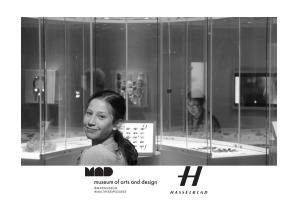In a recent post, I noted that museums seem to be shifting from education to engagement. I must admit that “engagement” has always seemed to me to be an ambiguous term, representing a reluctance to ask visitors to involve themselves with challenging content, and opening up the museum to any experience necessary to keep people there.
But comments to my post indicated a great interest in engagement. Futurist Garry Golden commented, “There is always risk of being seen as trendy or just buzz– but ‘engagement’ is a huge concept being explored today by people across the learning world…. I think engagement is a concept worth exploring.” And blogger Gretchen Jennings responded, in a post on her Museum Commons blog, that she has and continues to “[urge] museum educators to focus less on formal education materials and methods and more on interpretive planning in exhibitions and visitor engagement in the museum, both on site and online.
So I have decided to explore engagement in more depth. What is it, anyway? What would it mean for the-profession-formerly-known-as-museum- education to facilitate visitor engagement?
The Research
Garry directed me to the work of Valerie Hannon, who calls engagement the “golden key” to education.
You can watch this recent talk by Hannon yourself, but here are a few of Hannon’s ideas:
- In the school context, research demonstrates that engagement is an excellent predictor of success – in fact, engagement predicts success better than achievement does.
- “Engagement” is traditionally understood as engagement in school, and is defined by five characteristics:
- attendance
- attentiveness (eyes open and focused);
- conformity (joining school community);
- achieving some academic results;
- behavior / students are not misbehaving.
- Engagement in school is not the same thing as engagement in learning. Engagement in learning is better understood by looking at:
- whether students are energetic and enthusiastic
- passion
- learning all the time, everywhere
- students taking responsibility for own learning
- achieving a wider set of learning outcomes – not just in school subjects, but more broadly
- In schools, teachers often strive for engagement by one of two means: rewards (students who score well win a pizza party) or entertainment (teaching math through a rap). Neither rewards nor entertainment lead to true engagement.
- Hannon cite’s Daniel Pink’s theory that true engagement is motivated by autonomy (choice and control), mastery, and purpose (can connect learning to situations in your life / society)
Pink’s ideas complement those of Mihaly Csikszentmihaly, who wrote about engagement using the old-fashioned term “intrinsic motivation.” Csikszentmihaly tells us that when people are engaged they are in a “flow” state. Activities that lead to a flow state tend to have clear goals, appropriate rules, and opportunities for action in balance with the participant’s abilities. As one’s skills increase, the challenges increase. “When goals are clear, feedback unambiguous, challenges and skills well matched, then all of one’s mind and body becomes completely involved in the activity.”
Csikszentmihaly also writes about giving learners the opportunity to draw their own conclusions. “Information that is presented as true without alternative perspectives discourages the motivation to explore and learn more…. Motivated learning is an open process involving uncertainty and the discovery of new possibilities. A fixed presentation of the material thwarts such further exploration.”
In other words, engagement is not synonymous with fun. True engagement is defined by an individual’s choice to take on a difficult (but not too difficult) task that has relevance for him or her, whether it be physical (playing a sport or a musical instrument) or purely cognitive (making sense of competing ideas). Continued engagement is achieved through finding or creating new challenges, making the task harder as mastery increases. Video games often lead players through levels of increasing difficulty. A sports fan who is knowledgeable about basketball – who has perhaps learned about it by playing him or herself – is much more likely to be engaged in watching a game (making predictions and judging plays) than someone who has never previously attended to the sport.
Engagement Fail
Hannon’s talk points out that schools are using misguided tactics (rewards and entertainment) because they are identifying engagement by place (school) rather than activity (learning). Museums, of course, fall into this trap as well. We think about engaging visitors in activities that will make their museum time enjoyable, and measure engagement by how long visitors spend in the museum, for example, or by how attentive they seem.
But when visitors enjoy an interactive booth or a gallery activity, they are often not engaging in the ideas or work of the museum itself. An example: In June, I visited the Museum of Art and Design in New York City with my 12-year-old daughter, Charlotte. We saw Multiple Exposures: Jewelry and Photography, an exhibition of contemporary jewelry that, according the museum, “transform[s] and add[s] new meaning to the pervasive images of this digital age” as artists “explore changing views of beauty and the human body; examine social, political, and cultural issues; probe perceptions of memory and desire; and question the broader relation of jewelry to society and personal identity.”
While I explored the videos of artists examining ideas related to beauty, gold, and self-decoration (I can’t resist a few pictures, the exhibition was rather amazing)

and the necklaces inspired by 19th century mourning jewelry


my daughter found the “Auto-Selfie” station:


Charlotte loved it. She took picture after picture. It made the museum experience both memorable and exciting for her. But the Auto-Selfie booth neither illuminated the exhibition ideas nor added to her understanding of photography or “selfies.” Rather, it distracted her from the exhibition, which she barely looked at. Yes, she might want to go back to the museum again. But not out of an interest in the exhibitions or institution. She will be disappointed if there is no photo booth when she gets there. The Auto-Selfie provided Charlotte with 30 minutes of fun, but failed to engage her in any way that had a life beyond the activity itself.
Meaningful Engagement
I recently led a workshop for museum educators in Central Illinois. As a way of illustrating how goals should drive program decisions, I noted that gallery activities should lead participants back to the work, and help them look at or understand it in new ways. It was an audible “a-ha moment” for many in the group. “Oh yes,” you could hear them thinking, “we engage children in activities not just for fun, but because multisensory or independent activities help them understand the objects on view.”
Without facilitation, I’m not sure an activity station is an effective means of engagement. These stations distract children (and adults) from opportunities for real engagement. In a recent article for The Telegraph, Sally Saunders describes taking four young children to an exhibition of Matisse’s Cut-Outs at the Tate Modern; she describes the Drawing Bar, “a computer suite set up to allow budding artists to create their own artwork, electronically.” Saunders writes, “All four children find this incredible fun, and love seeing their pictures flash up on the giant screen above them. My friend and I are both worried that the highlight of the day will be a computer game.” Happily, Saunders is an expert at taking children to the museum, and, despite the many challenges, engages her children with the art itself.
If we want to engage visitors – to inspire passion, an interest in self-directed learning beyond the museum – what might that look like? Many museums have answered this in clever ways. I will never forget a visit to the British Galleries of the Victoria and Albert in 2004, making notes on brilliant gallery strategies, in particular loving a spiral-bound book exploring competing ideas and unsolved mysteries around a piece of furniture. More recently, I visited the terribly titled exhibition “Art as Therapy” at the Art Gallery of Ontario, which, despite some missteps, brilliantly rethought how a museum can spark a philosophical conversation through art. Still, as a field, we are inconsistent in our approach to and success with engagement.
Some strategies that we might continue to experiment with include:
- What if, instead of offering a stand-alone activity booth, the exhibition incorporated questions like this into the labels? What if instead of sites of knowledge, labels were sites of engagement – what might that look like?
- What if exhibitions were framed as questions instead of answers, sharing knowledge and challenging visitors to form their own opinions?
- What if supplementary, nearby materials allowed visitors to think about, for example, the ideas of elegy and mourning photos in different ways – through poetry, or modern uses of photography on social media or in newspapers?
Museum Educators as Facilitators of Engagement
What skills, then, must a museum professional have in order to support visitor engagement? What must the former-educator-who-is-now-an-engagement-officer bring to interpretive planning in order to supplement and not supplant the curator, exhibition designer, or project manager?
She or he must be knowledgeable about research in social sciences and education, comfortable with these disciplines and able to keep up with the literature.
She or he must be curious about how people learn from and respond to objects, as well as about the museum’s content and collection.
She or he must be interested in experimenting with interpretive strategies, and able to evaluate whether or not new strategies are effective.
And she or he must be familiar and comfortable with outcomes-based thinking — able to help the exhibition team articulate goals for visitors, and identify or invent strategies for achieving these goals.
These ideas about engagement are all new for me. Do they ring true? Is there other research we might look at? Other skills we need to successfully engage visitors?
On a related note, I just encountered this article about curiosity: http://www.theguardian.com/science/2014/oct/02/curiosity-memory-brain-reward-system-dopamine?CMP=twt_gu